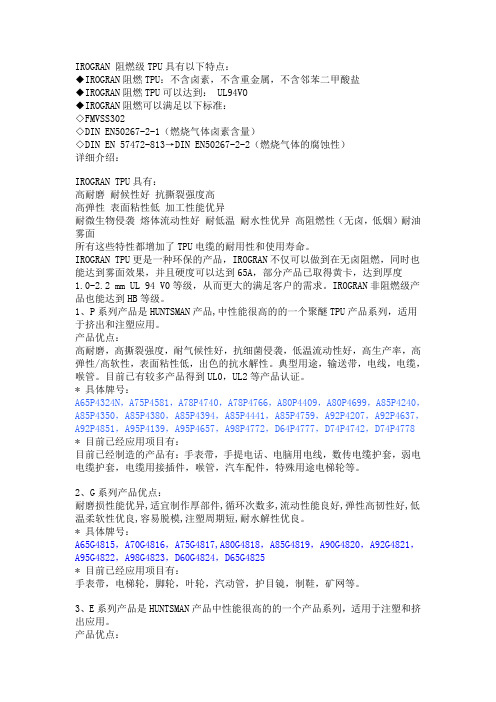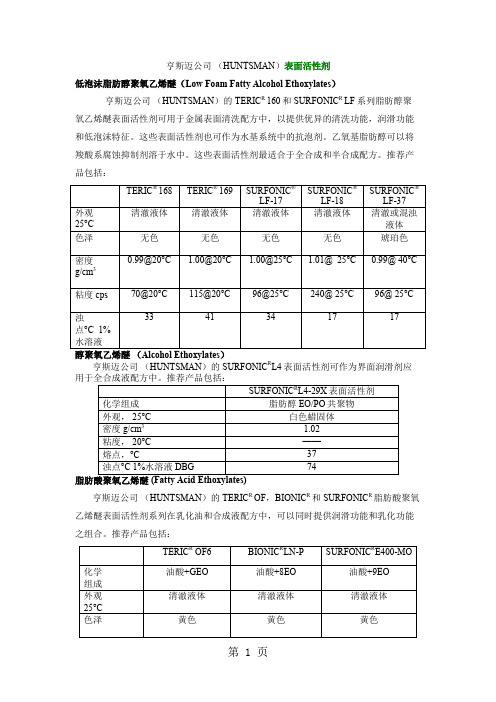亨斯迈-聚醚胺-产品综述
- 格式:pdf
- 大小:21.15 KB
- 文档页数:1



第47卷 第2期·62·CHINA RUBBER/PLASTICS TECHNOLOGY AND EQUIPMENT (PLASTICS )橡塑技术与装备(塑料)(2)山东滨华新材料有限公司碳三碳四综合利用项目山东滨华新材料有限公司碳三碳四综合利用项目位于山东省滨州市北海经济开发区滨州临港高端石化产业园,为国内首套自主研发共氧化法环氧丙烷技术产业化项目,项目采用轻质原料,绿色生产过程,产品面向高增长性新能源和新材料,主要建设60万t/年丙烷脱氢制丙烯装置、80万t/年丁烷异构化装置、30万t/年环氧丙烷(联产78万t/年叔丁醇)装置、15万t/年合成氨装置。
2020年8月5日,该项目公用工程开工。
摘编自“山东滨化”正大聚氨酯端氨基聚醚技术工艺装备国内领先Zhengda polyurethane amino-terminated polyether technologyand equipment are in a leading position in China2020年12月18日,中国聚氨酯工业协会组织专家在淄博对淄博正大聚氨酯有限公司完成的“临氢催化胺化法合成端氨基聚醚(聚醚胺)关键技术”项目进行了科技成果鉴定。
山东大学冯圣玉教授任主任委员的鉴定委员会认为,该项目工艺技术拥有自主知识产权,填补国内空白,工艺装备水平居国内领先,产品质量达国际先进水平。
正大聚氨酯开发的“临氢催化胺化法合成端氨基聚醚(聚醚胺)关键技术”项目以聚醚多元醇、液氨、氢气为原料,采用临氢催化胺化法合成端氨基聚醚(聚醚胺)的关键技术,生产高品质端氨基聚醚(聚醚胺),开发了新型催化剂和桨叶设备,催化剂使用寿命长,性能稳定;同时降低了反应温度和压力,副反应少,合成转化率高。
据了解,正大聚氨酯采用临氢催化胺化法开发了不同分子量的端氨基聚醚(聚醚胺)合成技术,并实现了产业化,填补了国内空白,打破了国外垄断,目前主导产品市场占有率国内第一。

聚醚胺——高性能环氧树脂固化剂什么是聚醚胺聚醚胺是一类主链为聚醚结构,末端活性官能团为胺基的聚合物。
通过聚乙二醇、聚丙二醇或者乙二醇/丙二醇共聚物在高温高压下氨化得到的。
通过选择不同的聚氧化烷基结构,可调节聚醚胺的反应活性、韧性、粘度以及亲水性等一系列性能,而胺基提供给聚醚胺与多种化合物反应的可能性。
其特殊的分子结构赋予了聚醚胺优异的综合性能,目前商业化的聚醚胺包括单官能、双官能、三官能,分子量从230到5000的一系列产品。
聚醚胺合成工艺聚醚胺的合成工艺包括间歇法和连续法两种工艺,Huntsman采用的生产工艺为连续的固定床工艺,利用负载在载体上的金属催化剂,其生产设备和工艺先进,催化剂效率高,因此产品转化率高,副反应少,生产成本低而且性能稳定,但是设备投资巨大。
相比于连续式生产,间歇式工艺设备投资小,可以方便的切换不同产品种类,但是生产效率较低,成本较高,同时产品质量与连续法相比也存在一定差距。
聚醚胺应用聚醚胺在聚脲喷涂、大型复合材料制成以及环氧树脂固化剂和汽车汽油清净剂等众多领域得到了广泛应用。
高性能复合材料:聚醚胺可以作为环氧树脂的高性能固化剂,用于生产高强度、高韧性的复合材料。
聚脲材料:聚醚胺为聚脲材料的关键组分,聚脲弹性体独特的防水、透气双重功能,在高铁桥梁、跨海大桥、水坝、大型场馆等混凝土结构的防水体系有很多应用实例,并表现出了优异的性能。
聚脲是异氰酸酯组份和氨基化合物组份反应生成的一种弹性体物质,也叫聚脲弹性体。
聚脲分为纯聚脲和半聚脲,性能不同,聚脲最基本的特性是防腐,防水,耐磨,抗冲击,抗老化性能优越。
可能很多小伙伴对聚脲材料不是太了解,老编特意找了一则关于聚脲材料与普通铁板防水性能比较的视频,一起来学习一下吧涂料:具有较低的粘度,应用于环氧地坪或者防腐涂料时,可以减少溶剂用量,降低体系粘度。
胶黏剂:作为环氧树脂固化剂,完全固化后具有极佳的韧性和耐疲劳性能,在胶黏剂和结构胶中应用广泛。

IROGRAN 阻燃级TPU具有以下特点:◆IROGRAN阻燃TPU:不含卤素,不含重金属,不含邻苯二甲酸盐◆IROGRAN阻燃TPU可以达到: UL94VO◆IROGRAN阻燃可以满足以下标准:◇FMVSS302◇DIN EN50267-2-1(燃烧气体卤素含量)◇DIN EN 57472-813→DIN EN50267-2-2(燃烧气体的腐蚀性)详细介绍:IROGRAN TPU具有:高耐磨耐候性好抗撕裂强度高高弹性表面粘性低加工性能优异耐微生物侵袭熔体流动性好耐低温耐水性优异高阻燃性(无卤,低烟)耐油雾面所有这些特性都增加了TPU电缆的耐用性和使用寿命。
IROGRAN TPU更是一种环保的产品,IROGRAN不仅可以做到在无卤阻燃,同时也能达到雾面效果,并且硬度可以达到65A,部分产品已取得黄卡,达到厚度1.0-2.2 mm UL 94 V0等级,从而更大的满足客户的需求。
IROGRAN非阻燃级产品也能达到HB等级。
1、P系列产品是HUNTSMAN产品,中性能很高的的一个聚醚TPU产品系列,适用于挤出和注塑应用。
产品优点:高耐磨,高撕裂强度,耐气候性好,抗细菌侵袭,低温流动性好,高生产率,高弹性/高软性,表面粘性低,出色的抗水解性。
典型用途,输送带,电线,电缆,喉管。
目前已有较多产品得到UL0,UL2等产品认证。
* 具体牌号:A65P4324N,A75P4581,A78P4740,A78P4766,A80P4409,A80P4699,A85P4240,A85P4350,A85P4380,A85P4394,A85P4441,A85P4759,A92P4207,A92P4637,A92P4851,A95P4139,A95P4657,A98P4772,D64P4777,D74P4742,D74P4778 * 目前已经应用项目有:目前已经制造的产品有:手表带,手提电话、电脑用电线,数传电缆护套,弱电电缆护套,电缆用接插件,喉管,汽车配件,特殊用途电梯轮等。

亨斯迈公司 (HUNTSMAN )表面活性剂低泡沫脂肪醇聚氧乙烯醚(Low Foam Fatty Alcohol Ethoxylates )亨斯迈公司 (HUNTSMAN )的TERIC R 160和SURFONIC R LF 系列脂肪醇聚氧乙烯醚表面活性剂可用于金属表面清洗配方中,以提供优异的清洗功能,润滑功能和低泡沫特征。
这些表面活性剂也可作为水基系统中的抗泡剂。
乙氧基脂肪醇可以将羧酸系腐蚀抑制剂溶于水中。
这些表面活性剂最适合于全合成和半合成配方。
推荐产品包括:亨斯迈公司 (HUNTSMAN )的SURFONIC R L4表面活性剂可作为界面润滑剂应亨斯迈公司 (HUNTSMAN )的TERIC R OF ,BIONIC R 和SURFONIC R 脂肪酸聚氧乙烯醚表面活性剂系列在乳化油和合成液配方中,可以同时提供润滑功能和乳化功能之组合。
推荐产品包括:亨斯迈公司(HUNTSMAN)的TERMUL R,SURFONIC R CO和DEHSCOFIX R CO 蓖麻油聚氧乙烯醚表面活性剂系列可作为乳化剂用于矿物油,植物油和酯类乳化油和半合成液中。
推荐产品包括:亨斯迈公司(HUNTSMAN)的TERIC®PE和SURFONIC®POA 环氧乙烷/环氧丙烷嵌段共聚物表面活性剂系列广泛应用于乳化油,半合成液和全合成液中,以提供优异的组合功能效应,包括润滑,乳化,溶解,增粘,润湿和分散功能等,同时具有低泡沫/消泡沫特征。
推荐产品:亨斯迈公司(HUNTSMAN)的TERIC®,EMPILAN® AMT,SURFONIC®和TERMET®胺聚氧乙烯醚可作为乳化剂用于乳化油和半合成液中,并可以提供腐蚀抑制功能。
推荐产品包括:亨斯迈公司(HUNTSMAN)的TERIC®X和N系列CO烷基酚聚氧乙烯醚表面活性剂是高效能表面活性剂,用于配制乳化油,半合成液和金属清洗剂。
亨斯迈产品–分散剂,润湿剂,中和剂JEFFSPERSE® X3204和JEFFSPERSE®X3503能有效的提高有机颜料和炭黑水性体系中的分散和分散稳定性特殊特性:适用于水性体系不含APEO,不含VOC ,广泛的树脂体系兼容性,降低研磨能耗和粘度,展色性优异应用实例:水性油墨,喷墨,水性涂料,色浆JEFFSPERSE® X3204 分散剂JEFFSPERSE® X3204是一款新型的用于水性油墨,水性涂料和色浆中有机颜料和炭黑的分散剂JEFFSPERS E® X3204聚合型分散剂具有竞争力在分散性及稳定性,适用于有机颜料和碳黑。
尤其适合于分散碳黑。
JEFFSPERSE® X3204聚合型分散剂非常有竞争力在色强和指研表现中。
附加值:JEFFSPERSE® X3204聚合型分散剂具有杰出的流变性能(低粘度和低触变性)。
提供丰富的色彩体系提升高颜添量JEFFSPERSE® X3204聚合型分散剂能够提供给最终涂料的附加值还有高光泽。
JEFFSPERSE® X3503 分散剂JEFFSPERSE® X3503聚合型分散剂具有竞争力在稳定性,适用于宽范围的有机颜料和碳黑中。
JEFFSPERSE® X3503聚合型分散剂非常有竞争力在色强和指研表现中。
附加值:JEFFSPERSE® X3503聚合型分散剂具有杰出的流变性能(低粘度和低触变性)提供丰富的色彩体系提升高的颜添加量JEFFSPERSE® X3503聚合型分散剂能够提供给最终涂料的附加值还有高光泽和低雾影。
HUNTSMAN 润湿剂OT-75 相比于市场上青特OT-75 和德固赛的DO-75,亨斯迈的产品性价比更高,产品批次稳定性也好HUNTSMAN 胺中和剂APMMEA-WB,亨斯迈是专业做胺类产品的化学公司,WB可以完全取代AMP-95,而且性价比高,产品气味低,颜色和稳定性好。
Technical BulletinJEFFAMINE® Amines as Curing Agents for EpoxyResins in CompositesComposites are defined as those materials which consist of two phases, a reinforcing phase and a stress transfer phase, or matrix. Fibrous reinforcing phases may be chopped, woven, or continuous. Advanced composites, in which reinforcement is provided by continuous fibers, provide high strength/weight ratios and are increasingly used in commercial applications.In addition to the high strength/weight ratio, advantages of composites can include lower maintenance, improved corrosion resistance, and automated part fabrication. Epoxy resins are the matrix polymers of choice in many of these applications because of their relatively low cost and high performance.Important considerations for matrix resin selection are processing and performance. Several processing techniques are used in composites manufacture. Among them are pultrusion, compression molding, resin transfer molding, and filament winding.Processing criteria include:• Reactivity--the resin system must be slow enough to avoid inconvenient viscosity increase and premature cure, yet it should cure at a reasonable rate when fabrication of the item is complete.• Viscosity--the resin system must be of sufficiently low viscosity to allow adequate fiber wet-out. Performance criteria include:• Strength/Modulus • Toughness • Corrosion resistance• Temperature resistance (T g, HDT)Epoxy resins are the well-suited to many of these applications because of their relatively low cost and high performance. In general epoxy resins may offer:• Good mechanical properties • Low formulation viscosity • Low shrinkage •Good adhesion to the reinforcement •Good chemical resistance.Their processing properties and performance depend, of course, on which specific resin/curing agent combination is used.A variety of curing agents for epoxy resins are available. Anhydrides provide good processing and mechanical properties but elongation is relatively low and the cure is rather slow. Aromatic amines present these problems as well as serious toxicity concerns in some cases. For many applications polyetheramines provide a good balance of processing and performance properties, and the JEFFAMINE amines are therefore finding wider use in composites.JEFFAMINE® Amines in Epoxy Curing Composite ApplicationsFeatures: • Flexible polyether backbone• Low viscosity• Moderatereactivity • Low volatility • Low exothermThe JEFFAMINE polyetheramines have a proven history in composite applications. One key structural charac-teristic is the steric hindrance (and resulting slower cure) provided by the presence of a methyl group on the amine-bearing carbon. As a result, these amines cure epoxy resins more slowly than do other aliphatic amines such as ethyleneamines. Another important structural feature is the flexible polyether backbone, which gives reduced brittleness in the cured resins. Good toughness, impact resistance, elongation, and low-temperature properties result from this flexibility.Formulated viscosities of the JEFFAMINE amines with typical epoxy resins at room temperature are in the 500-1500 cP range, allowing for good wet-out of fibers in processes such as filament winding. The products are virtually colorless as well.Features: • Tough cured resins:Higher elongationsImproved impact resistanceGood low-temperature properties•Good fiber wet-out •Balanced curing properties: Good working timeConvenient cure rates •Lower toxicity concerns •Lower safety concernsSince these amines are higher in molecular weight and lower in vapor pressure than other aliphatic amines, safety concerns are reduced.Molecular weights of the JEFFAMINE amines range from 148 to 5000, polyether backbones are based on ethylene glycol or propylene glycol, and amine functionality is one, two, or three. Products include•D-230, T-403, D-400•EDR-148•D-2000, T-5000.Of most interest for matrix resins are the diamines and triamines with molecular weights in the 200-500 range, the products known as JEFFAMINE D-230, T-403, and D-400 amines. In this product terminology the number gives the approximate molecular weight and the D- and T- denote diamine and triamine, respectively. The JEFFAMINE T-403 and D-230 amines have been the most widely used in composite applications. They are polypropylene glycol-based and are particularly well-suited because of their combination of moderate reactivity and good cured resin properties.Useful epoxy resins for this application include Dow's D.E.R. 383 and Shell's Epon 825 and 826; these have somewhat lower viscosities than the more commonly used resins. As shown in the Table, the working times for these formulations are adequate for most filament winding applications.Other properties are generally suitable as well. Elongation values of 10% or higher, tensile strengths in the 8,000-10,000 psi range, and flexural modulus values of around 400,000 psi or higher are typical. These high elongations lead to exceptional toughness and ductility which gives good damage tolerance, reducing the risk of catastrophic failure that might occur with more brittle systems. Cures with JEFFAMINE amines in general give lower T g values than some other curing agents--with T-403, for example, and a standard liquid bisphenol A resin, the T g is around 92°C (198°F). If a higher T g is required, other amines can be blended with the JEFFAMINE amines (see Table).Other members of the JEFFAMINE curing agent family include the ED- and EDR- series amines, which are poly ethylene glycol-based. The ED-series amines start at 600 molecular weight and have found little use in composites; XTJ-504 (prepared by amination of triethylene glycol diamine) is the lowest molecular weight amine in the series and may be suitable in some cases. This curing agent is more reactive than the amines mentioned earlier, because of its unhindered amine groups. High thermal shock resistance is a key feature of resins cured with this curing agent. The JEFFAMINE D-2000 and T-5000 curing agents, while not useful as sole curing agents for this application, may be included in blends with the other JEFFAMINE amines to increase flexibility and toughness. In some cases phase-separated systems are produced which may provide improved fracture resistance.SummaryThe JEFFAMINE polyetheramines are useful curing agents for composite matrix resins because of their curing characteristics and the cured resin properties they give. Their low viscosity, low volatility, and moderate cure rates make processing easier; the cured resins have good flexibility and toughness because of the amines' flexible polyether backbones. Compared with anhydride curing agents, these amines may give better composite matrices at lower cost.References:Morgan, Kong, Walkup Polymer 1984, 25, 375-386. "Structure-Property Relations of Polyethertriamine-Cured Bisphenol A-Diglycidyl Ether Epoxies"Morgan, Walkup J. Appl. Polymer Sci. 1987, 34, 37-46. "Epoxy Matrices for Filament-Wound Carbon Fiber Composites"。
亨斯迈公司(HUNTSMAN)表面活性剂低泡沫脂肪醇聚氧乙烯醚(Low Foam Fatty Alcohol Ethoxylates)亨斯迈公司(HUNTSMAN)的TERIC R 160和SURFONIC R LF系列脂肪醇聚氧乙烯醚表面活性剂可用于金属表面清洗配方中,以提供优异的清洗功能,润滑功能和低泡沫特征。
这些表面活性剂也可作为水基系统中的抗泡剂。
乙氧基脂肪醇可以将羧酸系腐蚀抑制剂溶于水中。
这些表面活性剂最适合于全合成和半合成配方。
推荐产品包括:TERIC® 168TERIC® 169SURFONIC®LF-17SURFONIC®LF-18SURFONIC®LF-37外观25°C 清澈液体清澈液体清澈液体清澈液体清澈或混浊液体色泽无色无色无色无色琥珀色密度g/cm30.99@20°C 1.00@20°C 1.00@25°C 1.01@ 25°C0.99@ 40°C 粘度cps70@20°C115@20°C96@25°C240@ 25°C96@ 25°C浊点°C1%水溶液3341341717醇聚氧乙烯醚(Alcohol Ethoxylates)亨斯迈公司(HUNTSMAN)的SURFONIC R L4表面活性剂可作为界面润滑剂应用于全合成液配方中。
推荐产品包括:SURFONIC R L4-29X表面活性剂化学组成脂肪醇EO/PO共聚物外观, 25°C白色蜡固体密度g/cm3 1.02粘度, 20°C——熔点,°C37浊点°C 1%水溶液DBG74脂肪酸聚氧乙烯醚 (Fatty Acid Ethoxylates)亨斯迈公司(HUNTSMAN)的TERIC R OF,BIONIC R和SURFONIC R脂肪酸聚氧乙烯醚表面活性剂系列在乳化油和合成液配方中,可以同时提供润滑功能和乳化功能之组合。